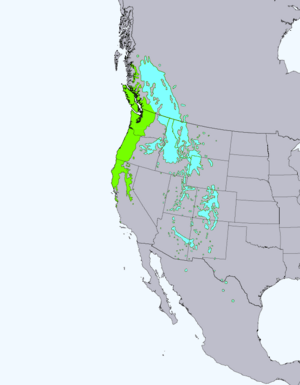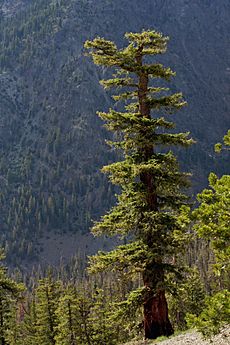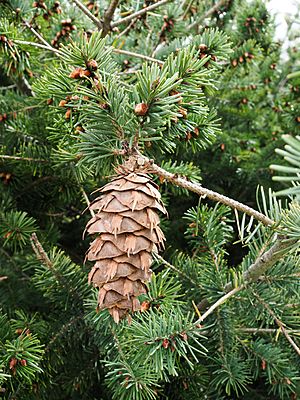Douglas fir facts for kids
Quick facts for kids Douglas-fir |
|
|---|---|
 |
|
| Rocky Mountain Douglas-fir forest in Pike National Forest, Colorado (United States). | |
| Conservation status | |
| Scientific classification | |
| Genus: |
Pseudotsuga
|
| Species: |
menziesii
|
 |
|
| Green: Coast Douglas-fir (Pseudotsuga menziesii var. menziesii)
Blue: Rocky Mountain Douglas-fir (Pseudotsuga menziesii var. glauca) |
|
| Synonyms | |
|
|
The Douglas-fir (Pseudotsuga menziesii) is a tall, evergreen tree. It belongs to the pine family, called Pinaceae. This tree is originally from western North America. People also know it as Douglas-fir, Douglas spruce, Oregon pine, or Columbian pine.
There are three main types, or varieties, of Douglas-fir. These are the coast Douglas-fir, the Rocky Mountain Douglas-fir, and the Mexican Douglas-fir.
Even though it has "fir" and "spruce" in its name, it's not a true fir or spruce tree. It's also not a pine or a hemlock. The scientific name "Pseudotsuga" actually means "false hemlock."
Scientists studied the Douglas-fir's huge genetic code in 2017. They found special genes that help the tree make food using sunlight.
Contents
Naming the Douglas-fir
The name Douglas-fir honors David Douglas. He was a Scottish botanist who first told people about this amazing tree. The name can be a bit confusing because it's not a "true fir." True firs belong to a different group of trees called Abies. That's why people often write it as "Douglas-fir" with a hyphen. This shows it's a unique type of tree.
The second part of its scientific name, menziesii, is named after Archibald Menzies. He was another Scottish doctor and naturalist. Menzies was the first to record this tree on Vancouver Island in 1791. Sometimes, people just call it "Doug fir." Other old names include Oregon pine or Douglas spruce.
Some Coast Salish people have their own names for the tree. In the Halkomelem language, it's called lá:yelhp. In the Lushootseed language, it's known as čəbidac.
What Does It Look Like?
Douglas-firs are evergreen trees that can be very tall. They usually grow between 20–100 metres (70–330 ft) (about 65 to 330 feet) high. Some coast Douglas-firs can reach these amazing heights. Their trunks can be up to 8 ft (2.4 m) wide.
The leaves are flat, soft, and about 2–4 centimetres (3⁄4–1+1⁄2 in) long. They look a bit like fir tree needles. You can tell a Douglas-fir because its leaves grow all around the branches. This makes it easy to spot! In thick forests, the lower branches might fall off. This means the leaves can start as high as 110 ft (34 m) off the ground. But if the tree gets more sunlight, its branches might be closer to the ground.
The female cones hang down from the branches. They have scales that stay on the cone. A cool thing about these cones is the three-pointed bract that sticks out from each scale. It looks a bit like the back half of a mouse, with two tiny feet and a tail!
Where Do Douglas-firs Grow?
The coast Douglas-fir (Pseudotsuga menziesii var. menziesii) grows along the coast. You can find it from west-central British Columbia down to central California. In Oregon and Washington, it grows from the Cascades all the way to the Pacific Ocean. In California, it grows in the Klamath Mountains and California Coast Ranges. It can be found near sea level up to 1,800 m (5,900 ft) (about 5,900 feet) high in the mountains.
Another type, the Rocky Mountain Douglas-fir (Pseudotsuga menziesii var. glauca), grows more inland. It can be found northward into central British Columbia. It also grows southeastward towards the Mexican border. The Mexican Douglas-fir is often seen as a type of P. menziesii. It grows as far south as Oaxaca, Mexico.
Douglas-fir in Nature
Douglas-fir trees like soils that are acidic or neutral. They can adapt well to different places. On drier lands, the coast Douglas-fir grows deep roots. The Rocky Mountain Douglas-fir can adapt even more. It grows in wet rainforests in British Columbia. It also grows in dry, grassy areas, where it develops even deeper roots.
Old Douglas-fir forests are home to certain animals. The red tree vole and the spotted owl live there. Spotted owls need large areas of old forest to live and raise their young. Red tree voles also live in these trees. They build their nests in the leaves, usually high off the ground. Their main food is Douglas-fir needles.
A parasitic plant called Douglas-fir dwarf mistletoe sometimes grows on these trees. Tiny insects called woolly conifer aphids also feed on Douglas-fir leaves. These insects are very small, about 0.5 mm long. They suck the sap from the leaves. They leave small white "fluff spots" of wax. Sometimes, they can make the leaves turn yellowish.

The coast Douglas-fir is the most common tree west of the Cascade Mountains. It grows well in most forest types. It can grow larger and faster than the Rocky Mountain Douglas-fir. Other trees that often grow with it include western hemlock, Sitka spruce, and sugar pine. Sometimes, you can find whole forests made only of Douglas-fir trees.
How People Use Douglas-fir
Douglas-fir is very important for forestry. It's often grown on special tree farms. Its wood is used to make timber.
The wood is strong, hard, and lasts a long time. People use it for building houses, floors, and furniture. It's also grown in Europe, Argentina, and Chile. In New Zealand, it's considered an invasive species. This means it grows too much and needs to be controlled.
Douglas-fir wood is popular for large timber structures. It's strong and can be cut into very long pieces, up to 60 feet. The wood also takes paint and stain well. Sometimes, timbers that haven't been dried might have sticky sap. Because it's strong and easy to get, Douglas-fir is used in many building projects.
These trees are also beautiful. People plant them in large parks and gardens.
The buds of the Douglas-fir have been used to flavor a type of fruit brandy called eau de vie.
Long ago, Native Hawaiian people used Douglas-fir logs that had drifted ashore. They used them to build their large double-hulled canoes.
Since the 1920s, Douglas-fir has been a popular Christmas tree. These trees are usually grown on special plantations.
You can also make pine-needle tea from Douglas-fir leaves. It has a tangy citrus taste. Some people use it in recipes as a wild substitute for rosemary.
Many different Native American groups used parts of the tree. They made herbal medicines from the bark, resin, and pine needles. These were used to treat various illnesses.
As of 2012, the only wooden ships still used by the United States Navy were Avenger-class minesweepers. These ships were made from Douglas-fir wood.
Images for kids
See also
 In Spanish: Abeto de Douglas para niños
In Spanish: Abeto de Douglas para niños





